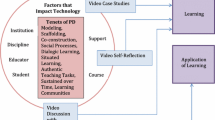Abstract
Using technology in medical education has drawn the attention of researchers in the last several years. Especially, videos have been found to promote effective learning in medical education. This study aims to examine general trends and results of articles investigating video usage in medical education and published in SSCI and ERIC journals from 2000 to 2014. For this purpose, the researchers systematically read and analyzed 43 relevant articles. Descriptive content analysis methodology was applied to examine the trends of studies on video usage in medical education. Researchers used a publishing classification form to categorize characteristics of the articles during content analyses. The results showed that the number of articles published about video usage in medical education particularly increased from 2009 to 2011. Instructional environments were the most common topic, the most frequently used video type was a case video, and the samples were mostly medical students. Quantitative methodology and analysis were employed regularly, and the most preferred data collection tool was a questionnaire. The reviewed articles suggested many benefits to using videos, such as enabling cognitive learning and gaining clinical skills. In conclusion, many studies have been published on video usage in medical education, and their general consensus is that video usage increases learning. Findings direct future studies on the subject.



Similar content being viewed by others
References
Albanese, M. (2005). Coming to a medical school near you: full motion video medical education. Medical Education, 39, 1081–1082.
Burke, S. C., & Snyder, S. L. (2008). YouTube: an innovative learning resource for college health education courses. International Electronic Journal of Health Education, 11, 39–46.
Çalık, M., & Sözbilir, M. (2014). İçerik analizinin parametreleri. Eğitim ve Bilim, 39, 33–38.
Cooper, J. B., Barron, D., Blum, R., Davison, J. K., feinstein, D., Halasz, J., Raemer, D., & Russell, R. (2000). Video teleconferencing with realistic simulation for medical education. Journal of Clinical Anesthesia, 12, 256–261.
Creswell, J. W. (2013). Research design: qualitative, quantitative, and mixed methods approaches (4th ed.,). Sage publications.
de Leng, B. A., Dolmans, D. H., van de Wiel, M. W., Muijtjens, A., & van der Vleuten, C. P. (2007). How video cases should be used as authentic stimuli in problem-based medical education. Medical Education, 41, 181–188.
Dick, R. W., Manson, S. M., Hansen, A. L., Huggins, A., & Trullinger, L. (2007). The native telehealth outreach and technical assistance program: a community-based approach to the development of multimedia-focused health care information. American Indian and Alaska Native Mental Health Research: The Journal of the National Center, 14, 49–66.
Duffy, P. (2007). Engaging the youtube google-eyed generation: strategies for using web 2.0 in teaching and learning, Remenyi (ed.), 6th European Conference on e-Learning, 2007 Denmark. Ecel, Denmark. 173-182.
Ekiz, D. 2003. Eğitimde araştırma yöntem ve metotlarına giriş: nitel. Nicel ve Eleştirel Kuram Metodolojileri, Anı Yayıncılık, Ankara.
Göktaş, Y., Küçük, S., Aydemir, M., Telli, E., Arpacık, Ö., Yıldırım, G., & Reisoğlu, İ. (2012). Türkiye’de eğitim teknolojileri araştırmalarındaki eğilimler: 2000–2009 dönemi makalelerinin içerik analizi. Kuram ve Uygulamada Eğitim Bilimleri Dergisi, 12, 177–199.
Katz, M. L., Heaner, S., Reiter, P., van Putten, J., Murray, L., Mcdougle, L., Cegala, D. J., Post, D., David, P., & Slater, M. (2009). Development of an educational video to improve patient knowledge and communication with their healthcare providers about colorectal cancer screening. American Journal of Health Education, 40, 220–228.
Knowles, C., Kinchington, F., Erwin, J., & Peters, B. (2001). A randomised controlled trial of the effectiveness of combining video role play with traditional methods of delivering undergraduate medical education. Sexually Transmitted Infections, 77, 376–380.
Kron, F. W., Gjerde, C. L., Sen, A. & Fetters, M. D. 2010. Medical student attitudes toward video games and related new media technologies in medical education. BMC Medical Education, 10 , 50.
Lohrmann, D. K. (2011). Thinking of a change: health education for the 2020 generation. American Journal of Health Education, 42, 258–269.
Lovell, K., & Vignare, K. (2009). MSU medical colleges blended learning for first year science courses: uniting pedagogy to maximize experience and real world limitations. Journal of Asynchronous Learning Networks, 13, 55–63.
Lynch, K., Barr, N., & Oprescu, F. (2012). Learning paramedic science skills from a first person point of view. Electronic Journal of e-Learning, 10, 396–406.
Managheb, S., Zamani, A., Shams, B. & Farajzadegan, Z. 2012. The effect of communication skills training by video feedback method on clinical skills of interns of isfahan university of medical sciences compared to didactic methods. Health Education Journal , 0017896912450823.
Mathews, C., Guttmacher, S., Coetzee, N., Magwaza, S., Stein, J., Lombard, C., Goldstein, S., & Coetzee, D. (2002). Evaluation of a video based health education strategy to improve sexually transmitted disease partner notification in South Africa. Sexually Transmitted Infections, 78, 53–57.
Mcmillan, J. H. & Schumacher, S. 2014. Research in education: evidence-based inquiry, Pearson Higher Ed.
Öndin, Z. 2008. İnteraktif videonun egitimde kullanılmasını saglayan Bir DVD uygulaması. Yayımlanmış Yükseklisans Tezi. Istanbul: Yıldız Teknik Üniversitesi Sosyal Bilimler Enstitüsü.
Schreiber, B. E., Fukuta, J., & Gordon, F. (2010). Live lecture versus video podcast in undergraduate medical education: a randomised controlled trial. BMC Medical Education, 10, 68.
Schwan, S., & Riempp, R. (2004). The cognitive benefits of interactive videos: learning to tie nautical knots. Learning and Instruction, 14, 293–305.
Yıldırım, N., & Özmen, B. (2012). Video paylaşim sitelerinin eğitsel amaçli kullanimi. NWSA: Education Sciences, 7, 288–295.
Author information
Authors and Affiliations
Corresponding author
Additional information
The first draft of this study was presented as oral presentation on 24–26 April 2014 at I. International EJER Congress.
Rights and permissions
About this article
Cite this article
Taslibeyaz, E., Aydemir, M. & Karaman, S. An analysis of research trends in articles on video usage in medical education. Educ Inf Technol 22, 873–881 (2017). https://doi.org/10.1007/s10639-015-9461-x
Published:
Issue Date:
DOI: https://doi.org/10.1007/s10639-015-9461-x




